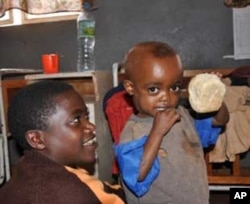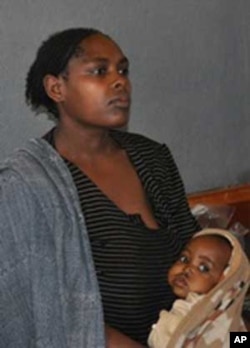Coffee farmers in the Gedeo district of southern Ethiopia grow the Yirgachefe, a highly prized brand within the coffee industry and among connoisseurs. These farmers usually do better than those in the rest of Ethiopia. But recent growing seasons have brought them nothing but despair.
Drought prevented the plants from producing beans, while the global economic downturn lead to a drop in the price of coffee fell on the global market. The combined effect has left many hungry.
Some of those affected include malnourished children at the Dilla Hospital feeding center.
Health worker Mahammed Kedir, who is on a routine check at Dilla, says children here spend a lot of time at home malnourished before they are brought for help.
HIV and TB compound malnutrition problems
"This child has been in a feeding center with a cough for one month. There is no improvement, no weight gain, no return of appetite,” he says. “This is most likely related to TB."
Mahammed is talking about a two-year-old orphan living with her aunt. It's the same for a three-year-old child who came to the hospital with her mother. Both the mother and the child are infected with HIV, and her husband is dead.
"She was admitted to the Gedeb feeding center," Mahammed says. They referred her to the hospital with a cough for about more than a month now. We have screened her for HIV and TB, and the tests were positive."
It’s not unusual for malnourished children with weakened immune systems to also have other diseases, including tuberculosis and HIV. Both may be passed on by their parents.
Another child with tuberculosis at the hospital is four-year-old Kefyalew. He does not have an adult with him. His 13-year-old brother Markos takes care of him. Markos and his three siblings are orphans. Their mother, who died of tuberculosis, told him that his father was killed by witchcraft.
Markos’s brother is severely malnourished, with a bulging stomach, bare skull and emaciated body. Markos says Kefyalew started losing his appetite after his mother died a year and half ago.
Near them, three other children are sleeping in a row of hospital beds. All of them are malnourished.
Effects of malnutrition
Malnutrition is a leading cause of death for children under five years of age. It makes them more vulnerable to infectious diseases including TB, and slows their recovery. Those who suffer from malnutrition may never attain maximum physical and mental potential. They may also suffer from stunted growth, and be physically weak and mentally slow.
Malnutrition can also be caused by birth spacing, the frequency between pregnancies. Women’s bodies regain lost nutrients between pregnancies; health specialists say the shorter the interval, the greater the likelihood of stunting and underweight babies.
Malnourishment also impacts pregnant women. The condition keeps blood from clotting and can lead to hemorrhaging, obstructed labor and death for either mother or child. It increases chances of premature or low-birth-weight and anemia. Also, undernourishment can affect the quality of breast milk, which draws proteins and other nutrients from the mother.
"I thought he was suffering from evil eye"
Some parents fail to realize their children are suffering from a lack of nutrients.
Almaz Buchie and her son Berhanu are also at the Dilla hospital feeding center.
"I took my son to a clinic near my home village. They said he is severely malnourished, and I need to take him to a feeding center. I noticed he was losing weight. But I thought he was suffering from evil eye. I did not know a food shortage was the problem," Almaz says.
The evil eye has nothing to do with it. Four-year-old Berhanu is malnourished and looks like a ten-month-old baby. His bones are tiny and he cannot walk. He crawls from his small hospital bed to his mother's bosom, but there's no milk.
It’s no help that Almaz and her husband are the poorest of the poor in her village. They used to work in other farmers’ fields as daily laborers. But now even the farmers can not even feed themselves. Almaz said times are tough.
"I have three more kids back home. They are all underweight but not as severely as this one. I don't have the means to feed them, and my husband is not working right now," she says.
Over the past year -- for the first time in decades – farmers in Gedeo district have been receiving food aid.
Now Gedeo is green and the rainy season has come. Hopes are high for the next cropping season. But farmers say there is no guarantee the rain fall will be consistent.
This is part 5 of our 15 part series, A Healthy Start: On the Frontlines of Maternal and Infant Care in Africa











